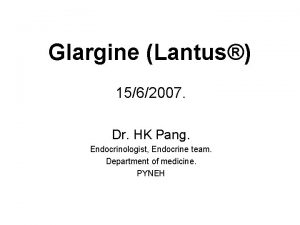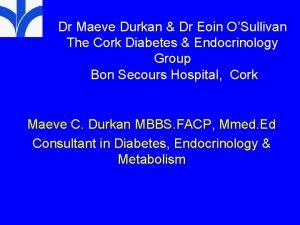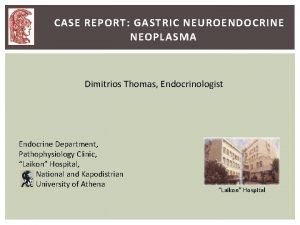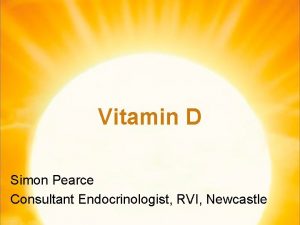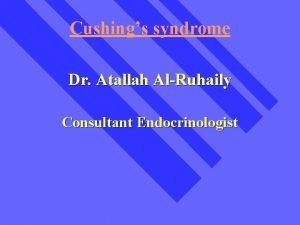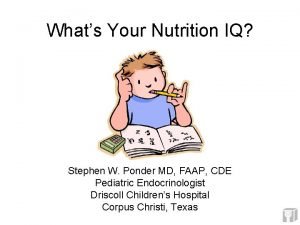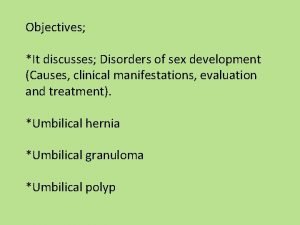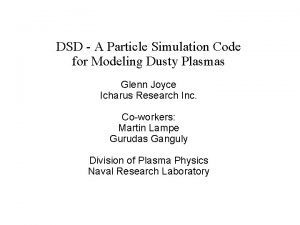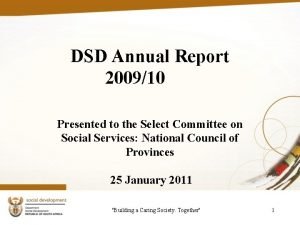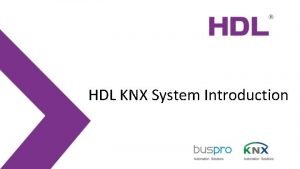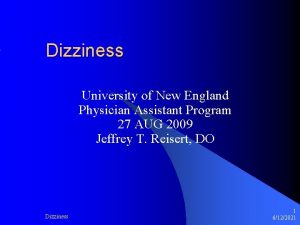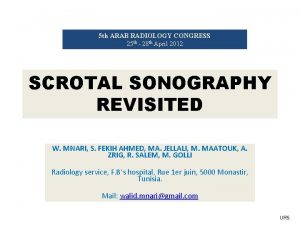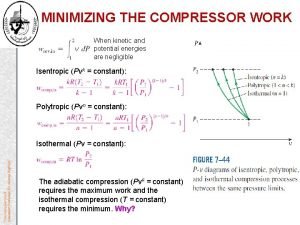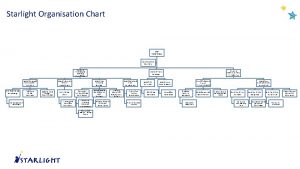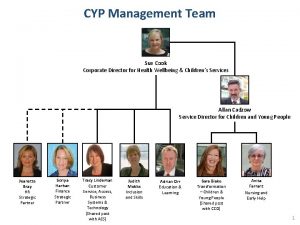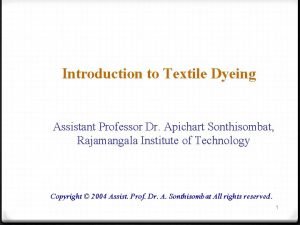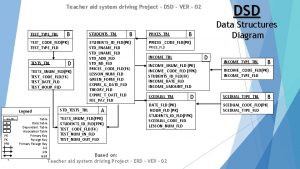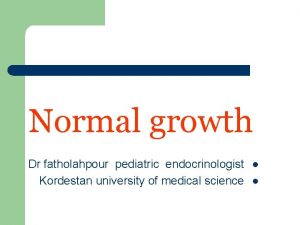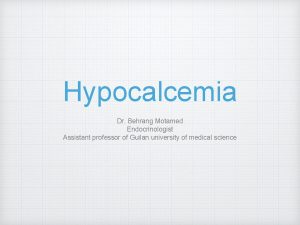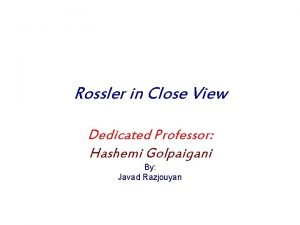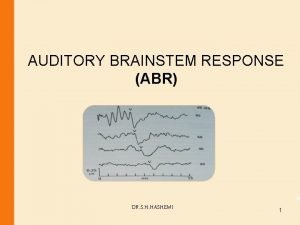46 xx DSD Dr Hashemi Pediatric Endocrinologist Assistant




























































- Slides: 60

46, xx DSD Dr. Hashemi Pediatric Endocrinologist Assistant Prof. of Shahrekord University Of Medical Sciences 1

Normal Sex Development The distinction between male and female is considered absolute so that sex assignment at birth is instantaneous. 2

Normal Sex Development ü Chromosomal sex ü Gonadal sex ü Phenotypic sex ü Brain sex 3

Chromosomal sex v Chromosomal sex refers to the karyotype • (46, XX, 46, XY ) 4

Gonadal Sex • The primitive gonad arises from urogenital ridge at approximately 4 to 5 weeks' gestation. 5

Gonadal Sex • The primitive gonad remains bipotential until about 40 days' gestation. 6

Testis Determination One of the first and most significant events in testis determination is SRY. 7

Ovarian Development • Ovarian development is an active process that requires expression of a set of specific genes: ü DAX 1 ü WNT 4 ü RSPO 1 8

Phenotypic Sex • The developing gonad produces several steroid and peptide hormones that mediate sexual differentiation and result in the phenotypic sex seen at birth. 9

Female Sexual Differentiation 10

Phenotypic Sex Female Sexual Differentiation internal genitalia • Müllerian structures persist to form: ü Fallopian tubes ü Uterus ü Upper portion of the vagina. 11

Phenotypic Sex Female Sexual Differentiation internal genitalia The lack of local testosterone production leads to degeneration of wolffian structures. 12

Phenotypic Sex Female Sexual Differentiation external genitalia 13

Disorders of Sex Development 14

Definition • Infants with a congenital discrepancy between external genitalia, gonadal and chromosomal sex are classified as having a disorder of sex development. 15

Disorders of Sex Development • Some DSDs present with abnormalities of the external genitalia (ambiguous genitalia). • Many of these individuals present as newborns with an atypical genital appearance often termed "ambiguous genitalia".

Classification Sex Chromosome DSD 46, XY DSD 46, XX DSD 17

46, XX DSD 18

Etiology of 46 xx DSD q A : Androgen Excess • • • 19 Congenital adrenal hyperplasia Aromatase deficiency Glucocorticoid receptor gene mutation Maternal source ( virilizing tumors e. g. luteoma) Androgenic drugs (progestron , testosterone , …)












Etiology of 46 xx DSD q A : Androgen Excess • • • 31 Congenital adrenal hyperplasia Aromatase deficiency Glucocorticoid receptor gene mutation Maternal source ( virilizing tumors e. g. luteoma) Androgenic drugs (progestron , testosterone , …)

32

Congenital adrenal hyperplasia • • 33 21 -Hydroxylase deficiency ( salt wasting) 11 Hydroxylase deficiency 3 BHSD deficiency ( salt wasting) POR deficiency


: • آﺰﻣﺎﻳﺸﺎﺕ ﺗکﻤیﻠی Testosterone = high 17 OHP = high DHEAS = NL Cortisol = low 35







: • آﺰﻣﺎیﺸﺎﺕ ﺍﺭﺳﺎﻟی • • 42 Na = NL K = NL Cortisol = NL 17 OHP = NL Testosterone = high Androstenedione = high Estradiol = low


Etiology of 46 xx DSD q A : Androgen Excess • • • 44 Congenital adrenal hyperplasia Aromatase deficiency Glucocorticoid receptor gene mutation Maternal source ( virilizing tumors e. g. luteoma) Androgenic drugs (progestron , testosterone , …)

45

Aromatase deficiency Ø Virilization since birth Ø Further virilization after birth Ø Ovarian failure to synthesize estrogen Ø Maternal serum levels of estrogen : very low Ø Serum levels of androgens : high 46

Aromatase deficiency Ø Large ovarian cysts bilaterally in ultrasonography. Ø Tall stature Ø Delay bone age 47






: • آﺰﻣﺎیﺸﺎﺕ ﺍﺭﺳﺎﻟی • • • 53 Na = NL K = LOW Cortisol = high ACTH = high Testosterone = high



Etiology of 46 xx DSD q A : Androgen Excess • • • 56 Congenital adrenal hyperplasia Aromatase deficiency Glucocorticoid receptor gene mutation Maternal source ( virilizing tumors e. g. luteoma) Androgenic drugs (progestron , testosterone , …)

Glucocorticoid receptor gene mutation Ø Mutation in the GR Ø Elevated cortisol levels Ø High ACTH Ø HTN Ø Hypokalemia Ø Elevated levels of adrenal androgens 57

Etiology of 46 xx DSD q B : Disorders of ovary development • Gonadal dysgenesis ( Turner syndrome & …. ) • Ovotesticular DSD ( True hermaphrodism ) • Testicular DSD ( 46, xx males ) 58

Etiology of 46 xx DSD q C : Other condition • Associated with GU and GI tract defects ( Mayer Rokitansky , …. ) 59

 Sidney pacific
Sidney pacific Hooman hashemi
Hooman hashemi Sayed hadi hashemi
Sayed hadi hashemi Saeid hashemi
Saeid hashemi Walled world map
Walled world map Dr pang endocrinologist
Dr pang endocrinologist Dr swade endocrinologist
Dr swade endocrinologist Endocrinologist in parbhani
Endocrinologist in parbhani Dr maeve durkan
Dr maeve durkan Dimitrios thomas endocrinologist
Dimitrios thomas endocrinologist Oha drugs
Oha drugs Dr. alireza amirbaigloo, md, endocrinologist
Dr. alireza amirbaigloo, md, endocrinologist Dr. alireza amirbaigloo, md, endocrinologist
Dr. alireza amirbaigloo, md, endocrinologist Endocrinologist lifestyle
Endocrinologist lifestyle Endocrinologist newcastle
Endocrinologist newcastle Terrence swade
Terrence swade Stephen ponder md
Stephen ponder md Dsd 1 pro
Dsd 1 pro Ovotesticular syndrome
Ovotesticular syndrome Dsd subject code
Dsd subject code Dsd programa
Dsd programa Dsd vizsga
Dsd vizsga Dsd disorder
Dsd disorder Leseverstehen teil 1
Leseverstehen teil 1 Dsd
Dsd Dsd mappe
Dsd mappe Dsd
Dsd Horverstehen
Horverstehen Schriftliche kommunikation übungen
Schriftliche kommunikation übungen Dsd 2 diplom
Dsd 2 diplom Dsd diplom
Dsd diplom Certification allemand kmk
Certification allemand kmk Dsd 1 schreiben
Dsd 1 schreiben Dsd 1 mk fragenkatalog
Dsd 1 mk fragenkatalog Dsd disorder
Dsd disorder Dsd annual report
Dsd annual report Dsd 1 leseverstehen
Dsd 1 leseverstehen Signmaker's assistant
Signmaker's assistant Hacheur assistant
Hacheur assistant Attribute assistant arcmap
Attribute assistant arcmap Knx topology
Knx topology University of new england physician assistant program
University of new england physician assistant program Bas health bakersfield adult school bakersfield, ca
Bas health bakersfield adult school bakersfield, ca Varicocele grading radiology assistant
Varicocele grading radiology assistant Isentropic efficiency for compressor
Isentropic efficiency for compressor Physician assistant kindergeneeskunde
Physician assistant kindergeneeskunde Login assistant
Login assistant Fglair setup
Fglair setup Mon assistant visuel sncf
Mon assistant visuel sncf Arbitre assistant robot
Arbitre assistant robot Good afternoon you
Good afternoon you Smart middle school
Smart middle school Research assistant career path
Research assistant career path Starlight assistant
Starlight assistant Mrs rajlaxmi is working
Mrs rajlaxmi is working Cisco configuration assistant (cca)
Cisco configuration assistant (cca) Cyp assistant director
Cyp assistant director Cooperative interview questions
Cooperative interview questions Printing and dyeing assistant
Printing and dyeing assistant Daq swim
Daq swim What are writing conventions
What are writing conventions





